第五章 19世纪上半叶的玻璃器(新古典主义,帝国风格,比徳迈式和洛可可复兴式)
新古典主义时期,玻璃制造业受到该时期推崇古代艺术的影响。玻璃器变得壁薄,简约,呈圆柱状。最主要的装饰工艺包括玻璃切割,雕刻,珐琅彩绘。帝国风格时期(受英格兰影响)出现了新型中空玻璃。生产的器物包括醋瓶和油瓶,水壶,长颈、短颈杯(著名的菜色碗),盐钵、啫喱碗等类型。这一时期运用了一种新的切割方法(凸钻雕刻)。最早在公元18 世纪晚期的不列颠群岛使用,这种装饰模式很快传播到欧洲大陆。在英国,法国,勃兰登堡和波希米亚,嵌瓷装饰水晶玻璃( 类瓷物质— 硫化物)非常受欢迎。浪漫主义的多彩风情使得玻璃制造中更加强调玻璃的丰富色彩。在比德迈式和洛可可复兴时期,绚丽多变的彩色玻璃更为流行,波希米亚便是中欧地区制作此种玻璃的领军者。极具成就的玻璃公司包括法国的巴卡拉(Baccarat),还有那些在英国伯明翰和斯陶尔布里奇的一些玻璃工厂也极富盛名。切割,轮盘雕刻(以实现更复杂的设计)以及彩绘仍是当时玻璃成型的主要技术工艺。
Glass of the First Half of the 19th Century (Neoclassicism, the Empire Style, Biedermeier, Rococo Revival)
During the Neoclassical period, glass production was influenced by the general admiration of Classical Antiquity. Glassware was now thin-walled and of simple, mostly cylindrical forms. The most prevalent decorative techniques included glass cutting, occasionally complemented with engraving, and painting in polychrome enamels. New types of hollow glass appeared during the Empire Style period (under England’s influence). These vessels included vinegar and oil cruets, water carafes, large, short-stemmed beakers (known as celery bowls), salts, jelly bowls, and other forms. In this connection, a new type of cut came into use (known as the raised-diamond cut). First employed in the British Isles in the late 18th century, this ornamental pattern rapidly spread to the European continent. In England, France, Brandenburg and Bohemia, glassware with porcelain-like objects encased in the glass (known as sulphides) was much sought after. Romanticism's love affair with colours led to a strong emphasis on coloured glass in glass manufacture. Glass made in a wide range of colours became even more popular during the Biedermeier and Rococo Revival periods. Bohemia was the leading manufacturer of this type of glass in central Europe. Highly accomplished European glass companies included the Baccarat glassworks in France, and those in Stourbridge and Birmingham in England. Cutting, wheel-engraving (with ever more intricate designs) and painting continued to be staple glass-finishing techniques.
V 19世纪上半叶的玻璃器(新古典主义,帝国风格,比德迈式和洛可可复兴式)
Glass of the First Half of the 19th Century (Neoclassicism, the Empire Style, Biedermeier, Rococo Revival)
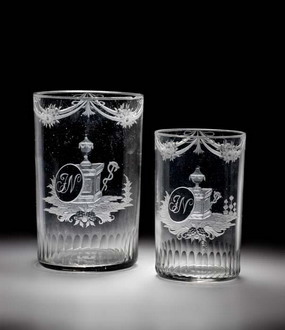
102
两件酒杯
南波希米亚,白银山(西尔博伯格),约1800年
无色透明玻璃,刻花和雕花;分别高11.8 cm和9.7 cm
编号 95 531/2,3
1988年从布拉格的赫蜜娜·杜什科娃处购得
Two beakers
Southern Bohemia, St?íbrny Vrch (Silberberg), c. 1800
Colourless glass, cut, engraved; H. 11.8 cm, H. 9.7 cm
Inv. no. 95?531/2,3
Purchased in 1988 from Hermína Du?ková, Prague
HB
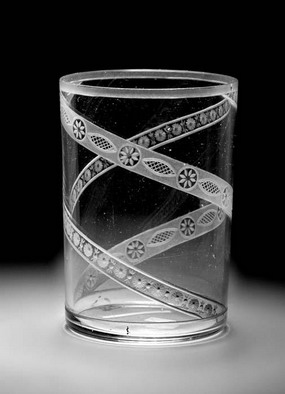
103
大酒杯
南波希米亚,白银山(西尔博伯格),约1800年
卡尔·约瑟夫·莱希纳工坊制作
无色透明玻璃,刻花和雕花;高9 cm
编号 8 784
1904年H. 卡策捐赠
卡尔·约瑟夫·莱希纳(1718–1806)工坊大量生产刻花玻璃,工坊位于格拉岑(新赫拉迪)附近山谷的一个村庄内。莱希纳出生于玻璃工匠世家,这个家族自17世纪以来一直受雇于当地领主——历代布奎伯爵。
Beaker
Southern Bohemia, St?íbrny Vrch (Silberberg), c. 1800
Carl Josef Lechner
Colourless glass, cut, engraved; H. 9 cm
Inv. no. 8?784
Donated in 1904 by H. Katzer
The prolific glass-cutting and engraving workshop run by Carl Josef Lechner (1718–1806) operated in the village of údolí near Nové Hrady (Niederthal bei Gratzen). Lechner was a member of a family of glass-decorators who were employed on the local estate of the Counts of Buquoy continually from the 17th century.
HB
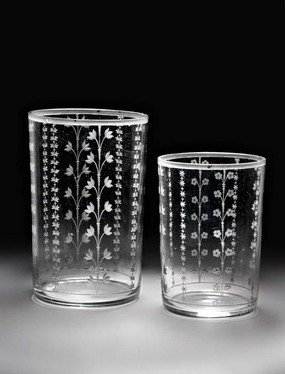
104
两件玻璃杯
南波希米亚,白银山(西尔博伯格),约1800年
卡尔·约瑟夫·莱希纳工坊制作
无色透明玻璃,刻花和雕花;分别高11.2 cm和9cm
编号 8 790,8 791
1904年H. 卡策捐赠
Two beakers
Southern Bohemia, St?íbrny Vrch (Silberberg), c. 1800
Carl Josef Lechner
Colourless glass, cut, engraved; H. 11.2 cm, 9cm
Inv. nos. 8?790, 8?791
Donated in 1904 by H. Katzer
HB
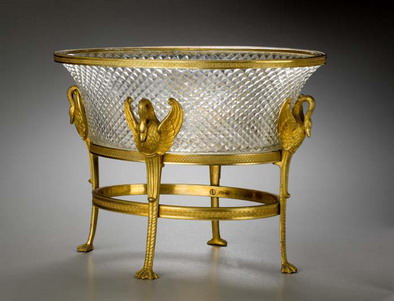
105
花盆
法国,约1810年
水晶玻璃,青铜鎏金配件;高31 cm,长29 cm,宽21.7 cm
编号 73 445
1970年购自布拉格的一家首饰店
Jardinière
France, c. 1810
Crystal glass, cut, gilt bronze mounting; H. 31 cm, L. 29 cm, W. 21.7 cm
Inv. no. 73?445
Purchased in 1970 from a Klenoty shop, Prague
HB
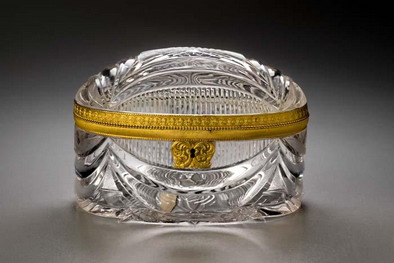
106
带盖子的糖缸
法国,19世纪早期
水晶玻璃,刻花,镶青铜鎏金口沿;高10.5 cm,长14 cm
编号 456
1886年由布拉格的沃伊切克·兰尼捐赠
这件藏品编号靠前,是在布拉格装饰艺术博物馆未成立前收购的。沃伊切克·兰尼在他的一次巴黎之行中购买了这件糖缸。
Covered sugar bowl
France, beginning of 19th century
Crystal glass, cut, bronze mounting; H. 10.5 cm, L. 14 cm
Inv. no. 456
Donated in 1886 by Vojtěch Lanna
This object with a low inventory number was acquired for the museum’s future collections before the museum was established. The piece is known to have been purchased by Vojtěch Lanna during one of his trips to Paris.
HB
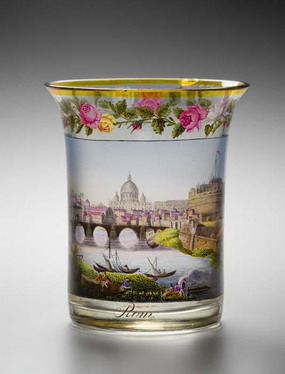
107
画着罗马风光的大酒杯
德国,德雷斯顿,萨穆埃尔·莫恩制作,约1811年
无色透明玻璃,刻花,透明色料彩绘;高10 cm
标记 S. Mohn fec.
编号 61 417
1962年通过所有权转让获得
Beaker with a view of Rome
Germany, Dresden, Samuel Mohn, c. 1811
Colourless glass, cut, painted in transparent colours; H. 10 cm
Marked: S. Mohn fec.
Inv. no. 61?417
Acquired in 1962 by ownership transfer
HB
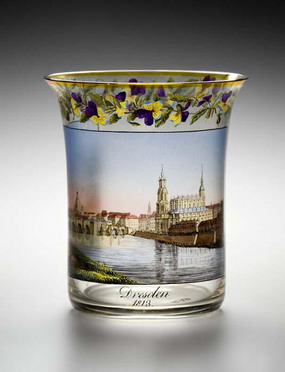
108
画有德雷斯顿风光的大酒杯
德国,德雷斯顿,萨穆埃尔·莫恩制作,约1813年
无色透明玻璃,刻花,透明色料彩绘;高10 cm
铭文 Dresden 1813
编号 17 707
1932年由斯图加特的古斯塔夫E.帕兹奥瑞克捐赠
玻璃杯纪念品中有的画着维也纳或布拉格的风光,也有的画着萨克森州首府德雷斯顿的风光。这类大酒杯大部分是萨穆埃尔·莫恩制作的,他儿子戈特利布也能做,戈特利布于1811年迁居维也纳。
Beaker with a view of Dresden
Germany, Dresden, Samuel Mohn, 1813
Colourless glass, cut, painted in transparentcolours, H. 10 cm
Inscription: Dresden 1813
Inv. no. 17?707
Donated in 1932 by Gustav E. Pazaurek, Stuttgart
Analogous to souvenir glasses featuring vedutas of Vienna or Prague are beakers with views of Dresden, the capital of Saxony. Such pieces were largely decorated by Samuel Mohn and later also his son Gottlieb, who moved to Vienna in 1811.
HB
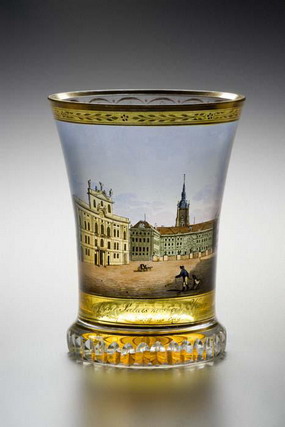
109
画着布拉格大主教宫殿的大酒杯
维也纳,约1820年
无色透明玻璃,刻花,透明色料彩绘,描金;高11.3 cm
金色铭文: Das Erzbisch?fliche Palais nebst dem Haupteingang der Konigl. Burg in Prag
编号 11 260
1909年购自维也纳的多若森姆拍卖会
Beaker with a view of Archibishop’s Palace in Prague
Vienna, c. 1820
Colourless glass, cut, painted in transparent colours and gold; H. 11.3 cm
Inscribed in gold: Das Erzbisch?fliche Palais nebst dem Haupteingang der Konigl. Burg in Prag
Inv. no. 11?260
Purchased in 1909 at the Dorotheum Auction, Vienna
HB
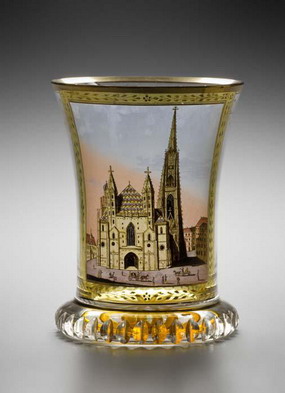
110
画着维也纳圣史蒂芬大教堂的大酒杯
维也纳,安东·考特伽色绘制,约1720年
无色透明玻璃,刻花,透明色料彩绘,描金;高10 cm
编号14 208
1916年从布拉格的爱德华·戈德堡处购得
安东?考特伽色(1769–1851)是维也纳擅长玻璃画和瓷画的一位艺术家,经他手制作了很多19世纪上半叶流行题材的纪念品玻璃杯。他最初在维也纳一家瓷器厂里任画师,后开设个人工坊,绘制了一批十分抢手的大酒杯,题材往往是维也纳和布拉格的风景以及西波希米亚的卡尔斯巴德等温泉小镇风光;有些玻璃器还被塑造成花朵式样,有的画着塔罗牌纹样,等等。这些酒杯的毛坯,尤其是兰夫特大酒杯,均从波希米亚的玻璃厂定制,其特征为底部有一个实心的圆盘形刻花足沿。
Beaker with a view of St. Stephen’s Cathedral in Vienna
Vienna, Anton Kothgasser, c 1720
Colourless glass, cut, painted in transparent colours and gold; H. 10 cm
Inv. no. 14?208
Purchased in 1916 from Ed. Goldberg, Prague
Anton Kothgasser (1769–1851), a glass and porcelain painter active in Vienna, created a great many souvenir glass objects with themes popular in the first half of the 19th century. The artist began his creative career as a painter in the Vienna porcelain manufactory. In his private workshop, he produced the highly coveted beakers with views of landmarks in Vienna and Prague, as well as Carlsbad and other spa resorts of western Bohemia, and also glass objects decorated with floral designs, motifs of taroc cards, and so forth. Blanks, especially Ranftbecher – beakers characterized by a solid, disc-shaped foot with a wide, cut rim around the bottom – were commissioned from Bohemian glassworks.
HB
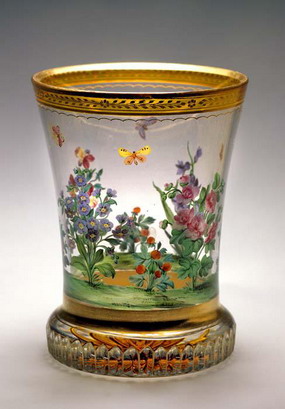
111
大酒杯
维也纳,约1820
无色透明玻璃,刻花,透明色料彩绘;高11 cm
编号 30 532
1949年从布拉格的V. 布塔处购得
Beaker
Vienna, c. 1820
Colourless glass, cut, painted in transparent colours; H. 11 cm
Inv. no. 30?532
Donated in 1949 by V. Butta, Prague
HB
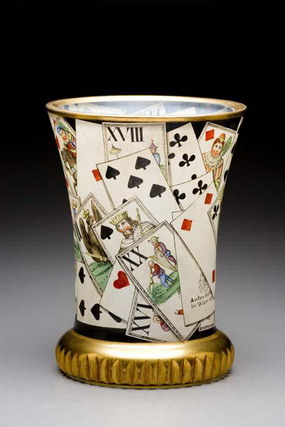
112
大酒杯
维也纳,安东·考特伽色制作,1830年
无色透明玻璃,刻花,珐琅彩绘,鎏金;高12.3 cm
标记: Anton Kothgasser in Wien 1830
编号 17 701
1932年由斯图加特的古斯塔夫E.帕兹奥瑞克捐赠
Beaker
Vienna, Anton Kothgasser, 1830
Colourless glass, cut, painted in enamels, gilded; H. 12.3 cm
Marked: Anton Kothgasser in Wien 1830
Inv. no. 17?701
Donated in 1932 by Gustav E. Pazurek, Stuttgart
HB | 